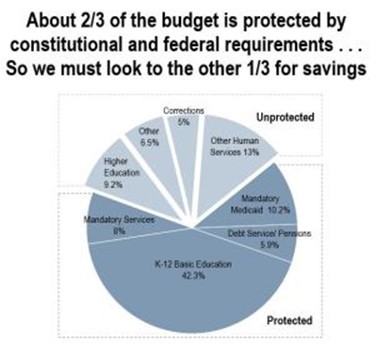We heard the news last week that revenues are up, because the economy is better, but that our state still faces a budget deficit of about $2 billion.
That’s not the same kind of deficit that exists in the federal budget. Washington state can’t borrow money or deficit-spend the way Congress can. Our budget has to balance every year.
So if Washington state’s budget is balanced every year, and revenues are going up, what’s this talk about a $2 billion deficit or shortfall?
Here’s a great summary in the Spokesman-Review:
Increases in the number of school children, Medicaid recipients, along with a proposed raise for state employees, will help drive the cost of current state programs up by about $2.65 billion in 2015-17. And that’s before increased spending for court-ordered improvements to public schools, which could be between $1 billion and $2 billion, and smaller class sizes mandated by a voter initiative.
The state Supreme Court issued a court order to lawmakers to boost education funding – to fully fund basic education. That’s because our state constitution explicitly lays out that education is our paramount duty.
During the Great Recession, everything got cut: prisons and parks, colleges and universities, health care. Since education is the biggest part of the budget, schools got hurt, too, and the court said “Okay, that’s enough. You have to fully fund the public schools.”
All these cuts happened as the state’s population actually grew. More people means higher costs … with less money to pay for it all. More from the Spokesman-Review post:
The state is also expected to have about 11,000 more students in public schools by 2015 and 36,500 more Medicaid recipients. It also expects to have more children in foster care and more criminals under community supervision. Tentative contracts with the state employees’ unions, which would cost some $500 million if both union and non-union workers got cost-of-living raises for the first time in seven years. Initiative 1351, which voters approved this month, could cost an estimated $4.7 billion over the next four years.
The majority of the budget is actually education to begin with. Add protected and mandatory funding and two thirds of the budget is protected, as this pie chart from House Appropriations Committee chair Rep. Ross Hunter shows:
If you’re interested in really digging into the numbers and the problem, Hunter’s blog post about the state budget situation really drills into it, but in an understandable way.
All that protected spending – mostly in education – means instead of instead of cutting everything a little, adding billions for education from the current budget means taking an axe to that remaining one-third. And that one-third includes things like our colleges, universities, hospitals, foster kids, and prisons.
There are hard decisions that will need to be made in the coming months.
